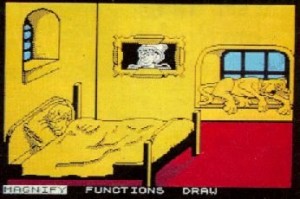
The screenshots looked amazing, the game was gonna be a stunner. The game was to be based on the LaserDisc Dragons Lair arcade, with what would be a basic interactive movie game…. very advanced and ahead of its time, especially for an 8-bit machine without such storage. Elite were crazy enough to try and defy the odds!
The game had countless adverts plastered around the pages of magazines such as CVG and Crash at the time. All we ever saw were the speccy looking cartoon shots, which still looked good. But no previews or reviews were ever seen of the game properly in action. Even the screenshots were clearly from a development package of some kind, due to the tool functions clearly still labelled at the foot of some of the shots.
Thanks to Rory Milne and a recent article for Retro Gamer magazine in 2016, we learn that Richard Wilcox was behind the design of a game which was aiming to make the most of a massive licence for Elite. Andy Williams would be on coding duties, and Jon Harrison on artwork. All of this is just for the ZX Spectrum as a starting point, C64 and Amstrad conversions would follow once the Spectrum version was close to completion.
It may seem crazy to even think to attempt such a thing on a basic and unexpanded 48k Spectrum (no talk of any memory expansions!), but they gave it a good go. Richard created a basic game engine that allowed the team to create interactive scenes and mini-games which were quite varied. The tool did some basic encoding to play back the levels in real time.
Jon Harrison had meticulously pixeled every screen, pixel by pixel (no video grabs!), and most of the game was actually fully designed. But he filled over 40 microdrives with just the graphics – which was to essentially kill the project. When doing a demo to Crash magazine, even Elite felt they were hitting problems when they would be seeing one scene play out, such as just the characters asleep and snoring, then it would require the next scene to be loaded in. Such a game would have been a nightmare on tape – and talk of using a compression technique and distribution on microdrive was quickly dismissed, as it was clear the medium wasn’t taking off.
The early and ambitious game was quietly put to bed – as the team came to the realization that this was something too ambitious.
Elite still had a licence, and got Gargoyle Games on-board to develop a replacement title. They were then given a short time limit to quickly program a Scooby-Doo platformer to save the licence. It was obviously rushed just to get something out there, but it was a reasonably solid release which made up for the lack of the earlier title to a degree.
What about a C64 version? Was it ever even started? We can confirm that there was nothing – and the game was canned before coding could start. The Spectrum would have led the way, and other conversions followed.
Thanks to the great spectrum “Games that time forgot” site, I have been able to include some scans of at least the Spectrum version. The C64 version could well have been straight ports of the graphics, or tidied up afterwards to feature more colours – we will never know.
But it is very possible that the real screens and remains could be seen by Spectrum owners some day. Jon Harrison has revealed that he still has all the microdrives with the graphics on, so it is hoped they will be preserved some day in the future. Nothing for the C64, but a key piece of unreleased games history solved at least.
Case closed!
Contributions: Chris Mehnert, Jason Kelk, Spectrum "Games That Time Forgot", Ross Sillifant, Rory Milne
Supporting content
Gallery
Related articles
Extracted from Crash magazine via Spectrum’s “Games That Time Forgot”…
So you thought you needed a laser disk system to run an interactive cartoon-based game? The Scooby Squad at Elite believe otherwise.., we checked out progress on the Spectrum cartoon-action game which should be released this month: SCOOBY-DOO
Eighteen months ago, a game called Blue Thunder appeared on the market. Written by a lad called Richard Wilcox, it was neatly tied in to the film and TV series which featured the mega helicopter of the same name, and it was judged a Good Game. Indeed, it was awarded Game of the Month status in Issue 3 of CRASH (in the days before the Smash had been invented).
Work on Blue Thunder began when Richard took a look at some of the Spectrum software available at the time and decided that he could do better. He did. Roping in his father to help market the game, Richard Wilcox Software came into being and Richard began a career as a games programmer.
About this time last year Kokotoni Wilf hit the streets – by then Richard Wilcox Software had become Elite. Kokotoni was a pretty good game, too, and things were looking good for Richard, and his father Brian – they roped in another member of the family to assist with marketing and organisational overheads of running a software house, Richard’s brother, Steve.

The opening screen of the first action sequence. A bedroom in Auntie’s castle. Shaggy is snoring in his bed, while Scooby slumbers on a ledge. Note the picture – in haunted houses, the eyes tend to move. Suddenly a trapdoor opens beneath Scooby and the startled hound is sliding down a refuse chute…
For a while, Elite’s fortunes took a bit of a dip. They got involved with licencing deals and released a couple of titles which weren’t so hot. They had the licences, but the software let them down somewhat – Dukes of Hazzard and 911TS. All the same, Fall Guy got a respectable rating, and Grand National was better still. Their latest game puts them firmly back in the running – Frank Bruno’s Boxing narrowly missed being a CRASH Smash and is doing well in the charts.
A conversion of International Basketball is nearing completion at Elite’s Aldridge headquarters, but another game is due for release this month which could set Elite amongst the leading software houses. Yes, it’s another tie-in, but this time the game looks like it will do the licenced characters, and Elite, proud.
Rather than produce a straight arcade adventure, the team of programmers working on the game of the cartoon Scooby-Doo decided to try for a very different game – a game in which you direct the action rather than play in the more usual “up/down, left/right” modes.
From the very start of the project, the plan was to produce a form of computer generated cartoon film, which starred the quintet of characters made famous in their adventures on the TV screen. Scooby-Doo cartoons all follow a similar storyline – the quartet of humans, aided and abetted by the lovable, easily scared and permanently hungry hound, find themselves investigating ghostly goings-on in a spine-tingling location.
While the artists in Elite’s Scooby Squad began studying videos of the cartoons, working out accurate animations from freeze framed action, the programmers set about developing a system which allowed them to compress data and combine screens and animation sequences so that a cartoon film could be squeezed into the Spectrum.
The plot soon developed. Set in a Scottish castle, Scooby-Doo, the game, features the ghost-hunting chums – Scooby, Shaggy, Fred, Daphne and Velma. Shaggy’s auntie owns the castle and has had spook trouble for sometime. She finally decides to leave her home forever when who should turn up, but her nephew Shaggy and his friends. Auntie is just leaving as they arrive and the gang persuade her to let them have a go at getting to the root of her hauntings.

Decision time as Scooby slithers down the refuse chute – time for you, the player to interfere… If you do nothing, Scooby will run into that central lump of stone and you will lose valuable time as the stunned dog recovers from his ordeal. Left or right – quick, make up your mind. You’re in the driving seat, after all!
Auntie agrees, and decides to go away but only for a couple of days while they try to sort things out for her- if they don’t work out what’s going on in 48 hours, however, she’s leaving and never coming back.
Essentially, the game will feature seven or eight action sequences which are separated by descriptive scenes in which characters in the game interact by meeting together and having a chat. The whale game is played against the clock, and to complete it you will need to go through all the levels and unmask the ‘spook’ who has been trying to scam Auntie off for so long.
In the action sequences you will follow Scooby and Shaggy as they search the castle and need to help them solve (or avoid) problems as they arise and generally guide them on their way. You drive the action in the game, acting rather like a film director, taking decisions which affect the outcome of events. After each action sequence has been played through, the scene will fade to a descriptive section where you eavesdrop on conversations and can pick up clues, tips and hints which will help you solve the mystery.
The cartoon quality of the game will be enhanced by the changing viewpoints from which you, the player/director, see the action. For instance, as Scooby is lolloping down a corridor you will see him full on, but when he nears a hidden trapdoor the screen might zoom in to show a close up of Scooby’s feet approaching the danger spot. Then it’s up to you to influence things…. Also, the sound effects will be synchronised to the action – helping to create the illusion that you are watching a cartoon and interfering with the outcome rather than just playing a computer game.
To complicate matters, different problems will crop up in the same action scene each time you load up and run the software – the game is not intended to have a single solution. It won’t be a single path; play it through once and that’s it, you know how to do the game.
When we visited the Scooby Squad they were confident that they had perfected the cartoon generating system that they would use to edit the screens into the finished game, and most of the design work on the individual screens – or ‘shots’ – from the storyboard had been committed to computer memory with the animation sequences. A few final details needed working out, and then the editing would begin. For with this game creating system, assembling the final program is rather like editing a film or videotape. The raw material is all there, as is the means to combine it into a sensible whole – it’s the skill of the editor that accounts for the polish of the finished product.
In the beginning, there was the text-only adventure game. Then came the adventure game with graphics, which developed into the arcade adventure. Elite could well take a significant step forward and become known as the creators of the Cartoon Adventure. Scooby’s a game to watch for…
Update history
- 29/12/16 – Scan added thanks to Ross Sillifant
- 07/02/16 – Full details of what happened to the project and confirmation that no C64 edition existed. Case closed!





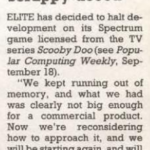
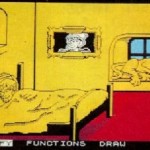
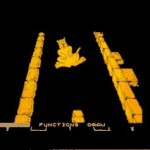
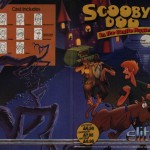
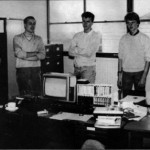

Is there a link to the Microdrive files? I’d like to download it.
I’m afraid not – the author is thinking of preserving the files soon and doing a remake game, but no news on that as of yet.
Thanks for responding! Let me know if the author has decided to upload the files so I can try to download it! :)
:-) Watch your inbox, i’ll be emailing over some addt.content on this one shortly.
Cheers Ross, adding now :)